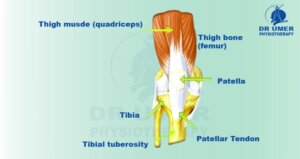Osgood-Schlatter disease is the most common cause of knee pain in growing children and adolescents. In OSD, pain and swelling occurs of the growth plate at the top of the shinbone. Osgood-Schlatter happens in those children who are more active such as runners and jumpers.
What is Osgood-Schlatter Disease?
Osgood- Schlatter disease occurs when the knee tendon pulls against the top of the shin bone. This causes pain and swelling in the upper part of shinbone. It is called Osgood Schlatter disease.
Description
At birth, the proximal epiphysis is composed of cartilage but contains an ossification center. Inside this ossification center starts to ossify or turn to bone. This process happens between the ages of 8 to 14 and becomes a bony tuberosity around the age of 18.
Growth plates are located at the ends of the long bones in our body. Growth plates grant our bones to get longer until we reach puberty. A bony prominence, called the tibial tuberosity. It is located in the uppermost portion of the shinbone and overlaps the growth plate. Patellar tendon also attaches there. Quadriceps muscles are located in the front part of the thigh, to pull on the patellar tendon and then pull on the tibial tuberosity. This pulling causes pain and inflammation. The repetitive stresses are very painful and force you to take rest. A hard bump also grows just below the knee as the growth plate hardens.

Why children are facing Osgood-Schlatter Disease?
Sporting movements heavily utilize the quadriceps muscles. The quadriceps muscles connect into the patellar tendon which connects into the tibial tuberosity. Patient feels pain and swelling in that area. The repeated movement of the quadriceps muscles that will cause repeated stress of the growth plate at the tibial tuberosity.
Symptoms of Osgood-Schlatter Disease
Symptoms may occur are;
- Pain and Swelling
- Bony bump below the knee
- Tightness in the quadriceps and hamstring
- Pain increase in movement and decrease in rest
- Symptoms appears after growth spurts
How is Osgood-Schlatter Disease diagnosed?
Osgood schlatter normally diagnose through examination and symptoms. The most common questions are;
- Your age and how long you have been suffering in this condition
- Your sports or other activities
Doctor can also suggest you the X-rays to see any other abnormality
Treatment
In Osgood schlatter disease, doctor first aim is to reduce pain and swelling. Doctor suggests you rest, rest is the key. You have to limit your activities such as games, running and jumping for few months. After reducing pain and swelling doctor or physical therapist plan strengthening exercises. It will help you to give life back normal.
Doctor may suggest you treatment in following steps:
Stretching exercises: Stretching the quadriceps and hamstring muscles allows for increasing mobility and less tension on the tibial tubercle resulting in decrease pain.
Ice: Put ice or a cold pack on the knee or inflamed area. It will help you to reduce pain and swelling.
Nonsteroidal anti-inflammatory drugs (NSAIDs): Drugs also helps you in reducing pain and swelling.
Conclusion
Osgood-Schlatter disease is the most common cause of knee pain in growing children. Osgood schlatter disease occurs when the knee tendon pulls against the top of the shin bone. Growth plates are located at the ends of the long bones in our body. Growth plates grant our bones to get longer until we reach puberty. The repeated movement of the quadriceps muscles that will cause repeated stress of the growth plate at the tibial tuberosity. The symptoms occur like pain and swelling etc. In treatment doctor suggest Stretching exercises, Ice and Nonsteroidal anti-inflammatory drugs for reducing pain and swelling.


